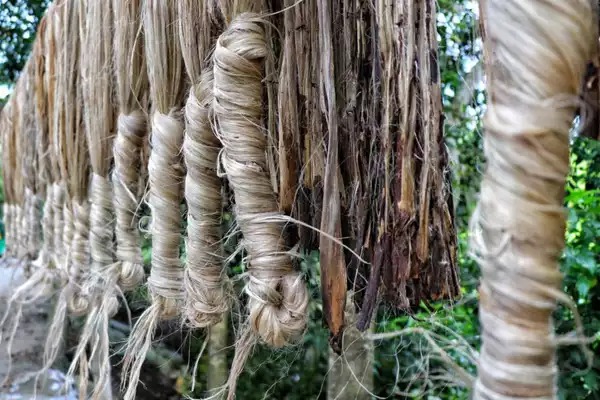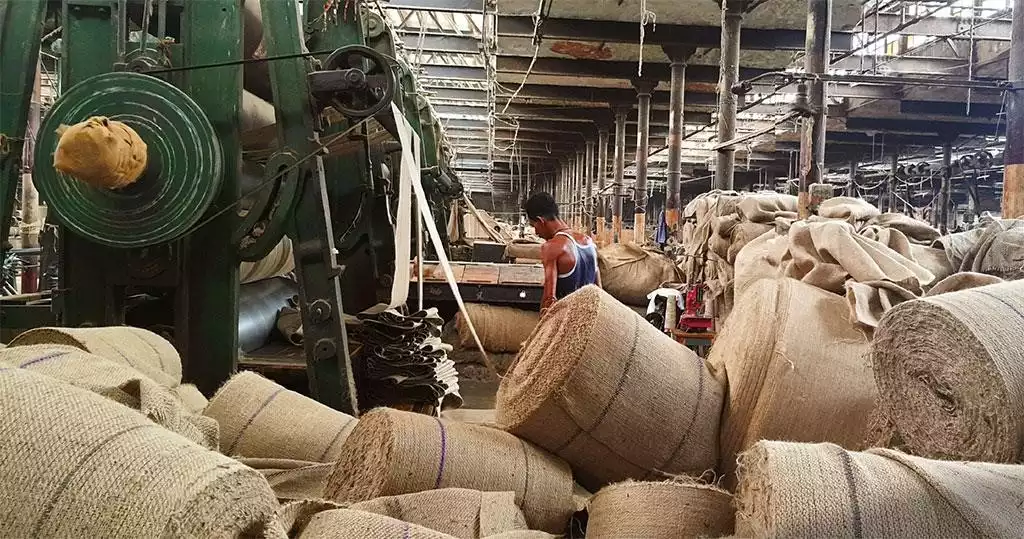The Standing Committee on Labour, Textiles and Skill Development released a report highlighting the development and promotion of the Jute Industry in India.
Jute Industry in India:
- India accounts for 70% of the world’s jute production.
- Employment: It employs around 3.7 lakh workers directly, with around 90% of the production being consumed locally.
- About 73% of jute industries are concentrated in West Bengal.
Production and Export Data:
- 2022-23 Production of Jute Goods: 1,246,500 metric tons (MT)
- 2022-23 Exports of Jute Goods: 177,270 MT, constituting 14% of the total jute goods production, marking a 56% increase in exports compared to 2019-20.
- 2022-23 Import of Raw Jute: 121.26 thousand MT, a significant increase from the previous year, mainly due to the high quality of imported jute from Bangladesh used for manufacturing value-added products.
- Top Export Markets: Countries that account for 70% of the jute goods exports include the USA, France, Ghana, the UK, The Netherlands, Germany, Belgium, Côte d’Ivoire, Australia, and Spain.
Production of Raw Jute and Jute Goods
- The production of raw jute and jute goods has shown fluctuation over the years, with a notable increase in production and exports in the recent fiscal year.
- Production of Raw Jute (in 000 bales): [Can be skipped]
- 2019-20: 9,445.8
- 2020-21: 8,952.6
- 2021-22: 9,908.1
- 2022-23: 9,664.3
- Production of Jute Goods (in 000 MT): [Can be skipped]
- 2019-20: 1,165.1
- 2020-21: 962.8
- 2021-22: 1,080.0
- 2022-23: 1,246.5
Challenges faced by the jute industry:
Agricultural:
- Declining acreage under jute cultivation due to competition from other crops.
- Inadequate availability of high-quality jute seeds.
- Traditional farming practices lead to low productivity (1.7 Lakh ha 2013-14 to 2021-22).
Technological and Industrial:
- Outdated machinery and technology in jute mills.
- High production costs compared to synthetic alternatives.
- Limited product diversification and innovation.
Market and Policy:
- Fluctuating demand in the global market.
- Competition from synthetic substitutes.
- Inadequate government support and policy measures.
Environmental and Sustainability:
- Issues related to the environmental sustainability of jute production.
- Challenges in promoting jute as an eco-friendly alternative.
Key Recommendations:
- Implementation of the National Jute Development Programme with specific schemes to enhance jute agriculture, modernization, diversification, and workers’ welfare.
- Encouragement of scientific jute cultivation and retting practices through the JUTE-ICARE program to improve fibre quality and productivity.
- Modernization of jute mills and MSME JDP units for the production of Jute Diversified Products (JDPs).
- Establishment of Jute Resource cum Production Centres (JRCPCs) and Jute Raw Material Banks (JRMBs) to support artisans and MSMEs.
- Incentives for the export of JDPs to make Indian jute products competitive in international markets.
- Promotion of jute in domestic markets through the Market Development & Promotion Scheme (MDPS) and support for jute design and innovation.
- Scholarship schemes for the girl children of jute workers to improve education standards.
Government Initiative:
- Certified Seeds Distribution: The Jute Corporation of India (JCI) has partnered with the National Seeds Corporation to distribute certified jute seeds, significantly impacting productivity and quality, benefiting around 5 lakh farmers.
- Jute Crop Information System: Collaboration with the National Remote Sensing Centre (NRSC-ISRO) for jute crop surveillance to monitor agronomy and enhance crop management.
- National Jute Development Programme: An Umbrella Scheme for development of Jute Industry.
- Jute Crop Information System: Collaboration with the National Remote Sensing Centre (NRSC-ISRO) for jute crop surveillance to monitor agronomy and enhance crop management.
- National Jute Board (NJB): It has been constituted as per the National Jute Board Act, 2008.
- Modernization Initiatives: Schemes for modernizing jute mills and the MSME sector, including the Incentive Scheme for Acquisition of Plant and Machinery (ISAPM) and Jute – ICARE (Improved Cultivation and Advanced Retting Exercise) to improve productivity and product quality.
- Jute Packaging Materials (Compulsory Use in Packaging Commodities) Act, 1987: It was enacted for the compulsory use of jute packaging material.
- Jute Mark Logo: It was launched (2022) for branding and positioning of Indian Jute globally.
Ref: Source
| UPSC IAS Preparation Resources | |
| Current Affairs Analysis | Topperspedia |
| GS Shots | Simply Explained |
| Daily Flash Cards | Daily Quiz |


